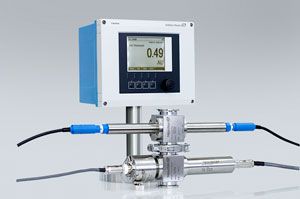Transmitter Interfaces with Analytical Sensors for Bio/Pharmaceutical Processes
Endress+Hauser’s Liquiline CM44P multichannel analyzer transmitter accepts and transmits parameters from analytical sensors and performs diagnostic functions.
Image courtesy of Endress+Hauser

Endress+Hauser’s Liquiline CM44P multichannel analyzer transmitter accepts up to 16 parameters from analytical sensors and transmits them via 4-20-mA HART, Profibus, Modbus or EtherNet/IP. The CM44P accepts inputs from up to two process photometers and four analytical sensors simultaneously. Sensor types include pH, oxidation-reduction potential (ORP), conductivity, dissolved oxygen, nitrate, turbidity, free chlorine, and ion-selective sensors. Mathematical functions allow the CM44P to calculate measured values on the basis of multiple input values.
The CM44P also performs diagnostics on all connected sensors and analyzers and transmits error messages. Some diagnostic functions include: monitoring impedance of pH glass, measuring signals for stagnation, monitoring the condition of electrodes and the degree of electrode aging, checking for overcurrent conditions, and comparing measured values of conductivity and temperature against tables defined in pharmacopeial specifications for pharmaceutical water.
An optional web server allows operators to remotely access the transmitter. Users can view measurement values or diagnostic messages or change device configuration using any web browser.
The CM44P interfaces to all Memosens sensors from Endress+Hauser and other vendors. Memosens is an international standard, with all sensor-related data stored directly in the sensor head. The CM44P can access this data for analysis, mathematical calculations, and diagnostic purposes and transmit it via various interfaces.
Multiparameter monitoring
Processes such as chromatography, fermentation, filtration, and phase separation require monitoring of multiple parameters. In chromatography, for example, the combination of an ultraviolet process photometer and pH, temperature, and conductivity sensor inputs ensures accurate detection of the target product. It also verifies buffer quality in the column is correct, leading to optimum product yield. In addition, the CM44P detects the transition from product to cleaning phase, allowing optimization of cleaning and flushing cycles in the column.
In fermentation, the combination of a process photometer measurement with pH and dissolved oxygen sensor inputs helps users achieve optimal growth conditions for microorganisms. Combining dissolved oxygen and turbidity measurements provides an accurate overview of a filtration process. Turbidity measurement indicates product purity, while dissolved oxygen measurement indicates if oxygen has penetrated the process, which could have an adverse effect on product quality.
Source: Endress+Hauser
Transformations in Drug Development for Cell and Gene Therapies
March 28th 2025As a recognized leader in immunophenotyping for clinical trials, Kevin Lang from PPD discusses how spectral flow cytometry is transforming drug development, particularly in cell and gene therapies like CAR-T. He also dives into his award-winning research, including his 2024 WRIB Poster Award-winning work, and his insights from presenting at AAPS PharmSci360.
The Role of Forced Degradation in Method Development, Manufacturability, and CMC Strategy
April 28th 2025Forced degradation studies are critical in biologics development, particularly for monoclonal antibodies (mAbs). These studies simulate long-term environmental stressors to uncover degradation pathways and ensure the stability of critical quality attributes (CQAs), aiding in robust chemistry, manufacturing, and controls (CMC) strategies and regulatory compliance.
Advancing Clinical Trials with Spectral Flow Cytometry: A Conversation with Kevin Lang
March 28th 2025As a recognized leader in immunophenotyping for clinical trials, Kevin Lang from PPD discusses how spectral flow cytometry is transforming drug development, particularly in cell and gene therapies like CAR-T. He also dives into his award-winning research, including his 2024 WRIB Poster Award-winning work, and his insights from presenting at AAPS PharmSci360.